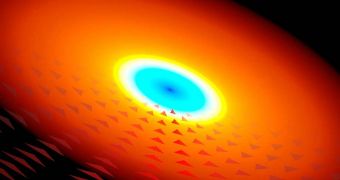During a recent study, astronomers stumbled upon a cosmic object called a quasi-stellar radio source (quasar) that did not adhere to the principles listed in the theory that was supposed to explain its behavior. Scientist will now have to rework their assumptions explaining these energetic structures.
A quasar is basically a very energetic and distant active galactic nucleus that releases vast amounts of light and radiations. One of their trademarks is the fact that the incredibly-strong winds they release push gases and other materials around them towards the fringe of their host galaxies.
However, the new study led to the discovery of a quasar whose neighborhood is very weird. Instead of pushing all other materials away from its core, this particular quasar can apparently also pull some gases and cosmic dust towards it. Under current theories explaining quasars, this should not happen.
After additional studies, researchers at the York University, in the United Kingdom, identified 17 more quasars where the same scenario occurred. These objects make up about 0.01 percent of all quasi-stellar radio sources discovered to date, Space reports.
“Matter falling into black holes may not sound surprising. But what we found is, in fact, quite mysterious and was not predicted by current theories,” explains York astronomer Patrick Hall, who was also the lead author of a paper published in the September 1 issue of the journal Monthly Notices of the Royal Astronomical Society.
Quasars even tend to push away gases that fuel the supermassive black holes at their cores, due to the fact that they release vast amounts of heat and radiations. The material is accelerated so fast, in fact, that it often reaches relativistic speeds (of up to 20 percent the speed of light).
“If the gas is falling into the black hole, then we don't understand why it's so rare to see infalling gas. There's nothing else unusual about these quasars. If gas can be seen falling into them, why not in other quasars?” Hall says.
The bizarre objects were found using the Sloan Digital Sky Survey (SDSS-III). The research group says that current models explaining the evolution and behavior of quasars may have to be revisited as a result of this study, so that these radio sources can be included in theories.

 14 DAY TRIAL //
14 DAY TRIAL //